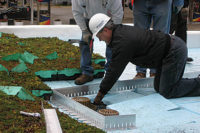Sustainable Roofing
Roofs and Water Conservation

Photos courtesy of Duro-Last.





Energy efficiency, longevity and durability are the most common topics when the roofing industry discusses environmentally friendly roof systems. But let’s not forget about other important items like materials (reuse, recycling) and water conservation. Clean water is something most people in the United States take for granted. We turn on the faucet and clean, drinkable water comes out. drinkable water comes out. So why discuss water in conjunction with roofs? Because roofs can contribute to water conservation and water cleanliness.
A building owner is able to use large amounts of water, and the local water utility will provide that water — but for a price. The water utility needs to filter and clean the water that is used at residential, industrial and commercial buildings. Filtering and cleaning water uses energy and costs money, and the costs are passed on to building owners. Another side of the water discussion is storm water that leaves a site. Many cities and towns charge a storm water fee, which is based on quantity. This is often the case in older cities that have old sewer systems, or combined sewer and storm water systems.
A roof can direct water to storage devices for later use, reducing the need for water from the utility; and a roof can capture water, delaying or preventing storm water from leaving the site. Both can reduce costs for a building owner.
There are a number of ways a roof can assist with water conservation, such as vegetative roofs, moisture mats, trays and cisterns. Roofing contractors can use RoofPoint© to advance the discussion about how a roof can help with water conservation. Within RoofPoint, there are two Water Management credits: Roof Storm Water Retention and Roof-related Water Use Reduction.
The intent of the Roof Storm Water Retention credit is to reduce the amount of water that leaves a roof immediately after a storm in order to minimize impacts on cities (e.g. storm water systems) and the natural environment (e.g. rivers, lakes).
A water retaining roof system can be vegetated or non-vegetated. Vegetated roofs should be self-sustained by non-potable or storm water (except during the plant establishment period). For RoofPoint credit, a vegetative roof needs to cover at least 75 percent of the roof surface. In lieu of a vegetative roof, moisture retention mats, trays or other devices (e.g. cisterns) can be used to capture and store water. For RoofPoint credit, 90 percent of a 1-inch rain over a 24-hour period needs to be retained.
Vegetation acts as a natural filter by removing unwanted pollutants from water. Water that is filtered through a vegetative roof will be cleaner when it is drained or captured. It doesn’t become drinkable, but this natural filtering reduces the pollutants that end up in the water cycle.
Another way to earn RoofPoint credit is to install a water-retention-ready roof. This might include a roof system with a durable membrane and cover board with appropriate traffic protection. Importantly, a water-retention-ready roof’s warranty should continue after installation of water-retention technologies.
The intent of the Roof-related Water Use Reduction credit is to increase water efficiency of a building by retaining and reusing roof storm water for onsite grey water use. Grey water can be used for landscaping and other non-potable systems, such as toilet flushing. It’s important to use water-storage devices that don’t allow water to evaporate, such as enclosed cisterns or buried storage tanks.
In addition to direct savings from storm water reduction and reducing the need for potable water, incentives and grants for water conservation are available at a state and/or local level. These range from tax rebates to direct payment per square foot for installed vegetative roofs. The website www.greenroofs.com is a comprehensive source for these incentives. The “Industry” section includes a list of cities and states that have incentives and rebates applicable to the installation of vegetative roof systems.
Considerable information about vegetative roofs also is available from Green Roofs for Sustainable Cities, accessible at www.greenroofs.org. Consider becoming a Green Roofing Professional as well. Also, NRCA’s Vegetative Roof Systems Manual is a good source for information about design and installation considerations.
Roofs are intended to keep water out of buildings, but roofs can also be used to help water conservation.
Looking for a reprint of this article?
From high-res PDFs to custom plaques, order your copy today!




.png?height=200&t=1740147695&width=200)



